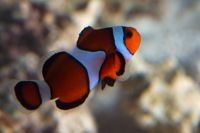Percula Clownfish (Amphiprion percula)
From The Aquarium Wiki
(Redirected from Blackfinned Clownfish)
Percula Clownfish
Amphiprion percula
76 Litres (20 US G.)
6.4-7.6cm (2.5-3 ")
8.1 - 8.4
22.2-25.6°C (72 -78 °F)
8-12 °d
1:1 M:F
2-5 years
Family
Pomacentridae
This animal is available captive bred
Contents
Additional names
- Percula Clownfish, True Percula Clownfish, Blackfinned Clownfish
Additional scientific names
- Amphiprion tunicatus, Lutjanus percula, Actinicola percula
Sexing[edit]
- Females are larger than the males.
Tank compatibility[edit]
- Percula Clownfish feed predominantly in the middle of the tank, although they can be observed nipping at plant matter throughout the tank. They are very peaceful and are generally compatible with most fish that are the same size. They should not be housed with Groupers, Sharks, Lionfish, Moray Eels or Rays. Caution should be taken when housing with Triggerfish and certain Wrasse.
Diet[edit]
- Percula Clownfish are omnivores. They should be fed a diet of brine shrimp, or chopped shrimp, squid or clams. They will also eat plant matter and can eat flake food, although the majority of their diet should consist of animal protein. They will also nip at algae and plant matter that grows in the aquarium and benefit from live rock growth.
Feeding regime[edit]
- Feed your Percula Clownfish two times daily, and only as much as they will eat in 2-3 minutes.
Environment specifics[edit]
- An adaptable saltwater fish that does well in a mature reef set up. Will commonly be associated with anemones such as Heteractis magnifica or Stichodactyla mertensii but captive bred fish will do perfectly fine without these and host long-tentacled corals instead.
Behaviour[edit]
- The Percula Clownfish are very peaceful, but can be aggressive towards other Clownfish in a smaller tank. They are active swimmers.
Identification[edit]
- Can look very similar to the False Percula Clownfish, the significant differences being that the True Percula has 11 dorsal spines and the False Percula has 10 dorsal spines. The True Percula can also develop thicker black tones in between the white bands along its flanks and is more pugnacious than False Percula.
Pictures[edit]
External links[edit]
- Fishbase (Mirrors:
 )
)



